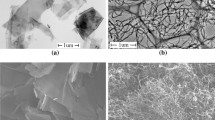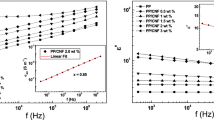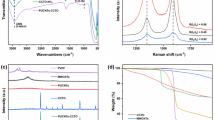Abstract
Composites based on poly(vinylidene fluoride) (PVDF) and different carbon additives, such as carbon nanofibers (CNF), graphite (G), expanded graphite (EG), and single-walled carbon nanotubes (SWCNT) have been prepared by nonsolvent precipitation, from solution, and subsequent melt processing. From a structural point of view, the α-crystal phase is the predominant crystal form in all the nanocomposites. However, those containing CNF, G, and EG at high nanoadditive content present also β-crystal phase. Even though the intrinsic thermal properties of PVDF are hardly affected, the nanoadditives act as nucleating agents for the crystallization. In regard to the electrical properties, all nanocomposites exhibit a percolating behavior. Moreover, the fact that the nanocomposites present both high dc conductivity and high dielectric constant, in a certain nanoadditive concentration range below the percolation threshold, suggests that a tunneling conduction mechanism for charge transport is present. With regard to the ac electrical properties, depending on the morphology of the different additives, the charge transport above percolation threshold can be explained taking into account the anomalous diffusion effect for high nanoadditive content or an intercluster polarization mechanism when the nanoadditive concentration decreases.








Similar content being viewed by others
References
Dong XM, Fu RW, Zhang MQ, Zhang B, Rong MZ (2004) Electrical resistance response of carbon black filled amorphous polymer composite sensors to organic vapors at low vapor concentrations. Carbon 42(12–13):2551–2559. doi:10.1016/j.carbon.2004.05.034
Hornbostel B, Leute U, Poetschke P, Kotz J, Kornfeld D, Chiu P-W, Roth S (2008) Attenuation of electromagnetic waves by carbon nanotube composites. Physica E-Low-Dimensional Syst Nanostruct 40(7):2425–2429. doi:10.1016/j.physe.2007.10.078
Balberg I (2002) A comprehensive picture of the electrical phenomena in carbon black-polymer composites. Carbon 40(2):139–143. doi:10.1016/s0008-6223(01)00164-6
Bloor D, Donnelly K, Hands PJ, Laughlin P, Lussey D (2005) A metal–polymer composite with unusual properties. J Phys D-Appl Phys 38(16):2851–2860. doi:10.1088/0022-3727/38/16/018
Wang SK, Chung DDL (2000) Electrical behavior of carbon fiber polymer-matrix composites in the through-thickness direction. J Mater Sci 35(1):91–100. doi:10.1023/a:1004744600284
Thostenson ET, Ren ZF, Chou TW (2001) Advances in the science and technology of carbon nanotubes and their composites: a review. Compos Sci Technol 61(13):1899–1912. doi:10.1016/s0266-3538(01)00094-x
Saito R, Dresselhaus G, Dresselhaus MS (1998) Physical properties of carbon nanotubes. Imperial College Press, London
O’Connell MJ (ed) (2006) Carbon nanotubes: properties and applications. Taylor & Francis, Boca Raton
Coleman JN, Khan U, Blau WJ, Gun’ko YK (2006) Small but strong: a review of the mechanical properties of carbon nanotube-polymer composites. Carbon 44(9):1624–1652. doi:10.1016/j.carbon.2006.02.038
Linares A, Canalda JC, Cagiao ME, Garcia-Gutierrez MC, Nogales A, Martin-Gullom I, Vera J, Ezquerra TA (2008) Broad-band electrical conductivity of high density polyethylene nanocomposites with carbon nanoadditives: multiwall carbon nanotubes and carbon nanofibers. Macromolecules 41(19):7090–7097. doi:10.1021/ma801410j
Kuilla T, Bhadra S, Yao D, Kim NH, Bose S, Lee JH (2010) Recent advances in graphene based polymer composites. Prog Polym Sci 35(11):1350–1375. doi:10.1016/j.progpolymsci.2010.07.005
Paszkiewicz S, Szymczyk A, Spitalsky Z, Soccio M, Mosnacek J, Ezquerra TA, Roslaniec Z (2012) Electrical conductivity of poly(ethylene terephthalate)/expanded graphite nanocomposites prepared by in situ polymerization. J Polym Sci Pt B-Polym Phys 50(23):1645–1652. doi:10.1002/polb.23176
Potts JR, Dreyer DR, Bielawski CW, Ruoff RS (2011) Graphene-based polymer nanocomposites. Polymer 52(1):5–25. doi:10.1016/j.polymer.2010.11.042
Sengupta R, Bhattacharya M, Bandyopadhyay S, Bhowmick AK (2011) A review on the mechanical and electrical properties of graphite and modified graphite reinforced polymer composites. Prog Polym Sci 36(5):638–670. doi:10.1016/j.progpolymsci.2010.11.003
Lovinger AJ (1983) Ferroelectric polymers. Science 220(4602):1115–1121. doi:10.1126/science.220.4602.1115
Kochervinskii VV (2003) Piezoelectricity in crystallizing ferroelectric polymers: poly(vinylidene fluoride) and its copolymers (a review). Crystallogr Rep 48(4):649–675. doi:10.1134/1.1595194
Lovinger AJ (1981) Unit-cell of the gamma-phase of poly(vinylidene fluoride). Macromolecules 14(2):322–325. doi:10.1021/ma50003a018
Bachmann MA, Lando JB (1981) A reexamination of the crystal-structure of phase-II fo poly(vinylidene Fluoride). Macromolecules 14(1):40–46. doi:10.1021/ma50002a006
Zhao Z, Zheng W, Yu W, Long B (2009) Electrical conductivity of poly(vinylidene fluoride)/carbon nanotube composites with a spherical substructure. Carbon 47(8):2118–2120. doi:10.1016/j.carbon.2009.03.043
Peng Q-Y, Cong P-H, Liu X-J, Liu T-X, Huang S, Li T-S (2009) The preparation of PVDF/clay nanocomposites and the investigation of their tribological properties. Wear 266(7–8):713–720. doi:10.1016/j.wear.2008.08.010
Yan L, Li YS, Xiang CB (2005) Preparation of poly(vinylidene fluoride) (PVDF) ultrafiltration membrane modified by nano-sized alumina (Al2O3) and its antifouling research. Polymer 46(18):7701–7706. doi:10.1016/j.polymer.2005.05.155
Bhatt AS, Bhat DK (2012) Crystallinity, magnetic and electrochemical studies of PVDF/Co3O4 polymer electrolyte. Mater Sci Eng B-Adv Funct Solid-State Mater 177(2):127–131. doi:10.1016/j.mseb.2011.09.036
Kremer F, Schönhals A (2002) Broadband dielectric spectroscopy. Springer, Berlin
Lovinger AJ (1982) Developments in crystalline polymers. Applied Science, London
Haggenmueller R, Fischer JE, Winey KI (2006) Single wall carbon nanotube/polyethylene nanocomposites: nucleating and templating polyethylene crystallites. Macromolecules 39(8):2964–2971. doi:10.1021/ma0527698
Hernandez JJ, Garcia-Gutierrez MC, Nogales A, Rueda DR, Ezquerra TA (2009) Shear effect on crystallizing single wall carbon nanotube/poly(butylene terephthalate) nanocomposites. Macromolecules 42(13):4374–4376. doi:10.1021/ma900446e
Chiu F-C (2014) Comparisons of phase morphology and physical properties of PVDF nanocomposites filled with organoclay and/or multi-walled carbon nanotubes. Mater Chem Phys 143(2):681–692. doi:10.1016/j.matchemphys.2013.09.054
Lincoln DM, Vaia RA, Krishnamoorti R (2004) Isothermal crystallization of nylon-6/montmorillonite nanocomposites. Macromolecules 37(12):4554–4561. doi:10.1021/ma049768k
Neidhofer M, Beaume F, Ibos L, Bernes A, Lacabanne C (2004) Structural evolution of PVDF during storage or annealing. Polymer 45(5):1679–1688. doi:10.1016/j.polymer.2003.12.066
Alizadeh A, Richardson L, Xu J, McCartney S, Marand H, Cheung YW, Chum S (1999) Influence of structural and topological constraints on the crystallization and melting behavior of polymers. 1. Ethylene/1-octene copolymers. Macromolecules 32(19):6221–6235. doi:10.1021/ma990669u
Li L, Li CY, Ni C, Rong L, Hsiao B (2007) Structure and crystallization behavior of Nylon 66/multi-walled carbon nanotube nanocomposites at low carbon nanotube contents. Polymer 48(12):3452–3460. doi:10.1016/j.polymer.2007.04.030
Wu D, Sun Y, Wu L, Zhang M (2008) Linear viscoelastic properties and crystallization behavior of multi-walled carbon nanotube/polypropylene composites. J Appl Polym Sci 108(3):1506–1513. doi:10.1002/app.27793
Nakagawa K, Ishida Y (1973) Annealing effects in poly(vinylidene fluoride) as revealed by specific volume measurements, differential scanning calorimetry, and electron microscopy. J Polym Sci Pt B-Polym Phys 11(11):2153–2171. doi:10.1002/pol.1973.180111107
Xu J-Z, Zhong G-J, Hsiao BS, Fu Q, Li Z-M (2014) Low-dimensional carbonaceous nanofiller induced polymercrystallization. Prog Polym Sci 39:555–593
Xu J-Z, Liang Y-Y, Zhong G-J, Li H-L, Chen C, Li L-B, Li Z-M (2012) Graphene oxide nanosheet induced intrachain conformational ordering in a semicrystalline polymer. J Phys Chem Lett 3(4):530–535. doi:10.1021/jz300062z
Jonscher AK (1977) Universal dielectric response. Nature 267(5613):673–679. doi:10.1038/267673a0
Stauffer D (1979) Scaling theory of percolation clusters. Phys Rep-Rev Sect Phys Lett 54(1):1–74. doi:10.1016/0370-1573(79)90060-7
Bauhofer W, Kovacs JZ (2009) A review and analysis of electrical percolation in carbon nanotube polymer composites. Compos Sci Technol 69(10):1486–1498. doi:10.1016/j.compscitech.2008.06.018
Barrau S, Demont P, Peigney A, Laurent C, Lacabanne C (2003) DC and AC conductivity of carbon nanotubes–polyepoxy composites. Macromolecules 36(14):5187–5194. doi:10.1021/ma021263b
Sandler JKW, Kirk JE, Kinloch IA, Shaffer MSP, Windle AH (2003) Ultra-low electrical percolation threshold in carbon–nanotube–epoxy composites. Polymer 44(19):5893–5899. doi:10.1016/s0032-3861(03)00539-1
Carmona F, Prudhon P, Barreau F (1984) Percolation in short fibers epoxy–resin composites—conductivity behavior and finite size effects near threshold. Solid State Commun 51(4):255–257. doi:10.1016/0038-1098(84)91008-1
Balberg I, Anderson CH, Alexander S, Wagner N (1984) Excluded volume and its relation to the onset of percolation. Phys Rev B 30(7):3933–3943. doi:10.1103/PhysRevB.30.3933
Connor MT, Roy S, Ezquerra TA, Calleja FJB (1998) Broadband ac conductivity of conductor–polymer composites. Phys Rev B 57(4):2286–2294. doi:10.1103/PhysRevB.57.2286
Dyre JC, Schroder TB (2000) Universality of ac conduction in disordered solids. Rev Mod Phys 72(3):873–892. doi:10.1103/RevModPhys.72.873
Gefen Y, Aharony A, Alexander S (1983) Anomalous diffusion on percolating clusters. Phys Rev Lett 50(1):77–80. doi:10.1103/PhysRevLett.50.77
Song Y, Noh TW, Lee SI, Gaines JR (1986) Experimental-study of the 3-dimensional ac conductivity and dielectric-constant of a conductor–insulator composite near the percolation-threshold. Phys Rev B 33(2):904–908. doi:10.1103/PhysRevB.33.904
Bergman DJ, Imry Y (1977) Critical behavior of complex dielectric-constant near percolation threshold of a heterogeneous material. Phys Rev Lett 39(19):1222–1225. doi:10.1103/PhysRevLett.39.1222
Laibowitz RB, Gefen Y (1984) Dynamic scaling near the percolation-threshold in thin au films. Phys Rev Lett 53(4):380–383. doi:10.1103/PhysRevLett.53.380
Straley JP (1977) Critical exponents for conductivity of random resistor lattices. Phys Rev B 15(12):5733–5737. doi:10.1103/PhysRevB.15.5733
Viswanathan R, Heaney MB (1995) Direct imaging of the percolation network in a 3-dimensional disordered conductor–insulator composite. Phys Rev Lett 75(24):4433–4436. doi:10.1103/PhysRevLett.75.4433
Schaefer DW, Justice RS (2007) How nano are nanocomposites? Macromolecules 40(24):8501–8517. doi:10.1021/ma070356w
Bauer BJ, Hobbie EK, Becker ML (2006) Small-angle neutron scattering from labeled single-wall carbon nanotubes. Macromolecules 39(7):2637–2642. doi:10.1021/ma0527303
Nogales A, Broza G, Roslaniec Z, Schulte K, Sics I, Hsiao BS, Sanz A, Garcia-Gutierrez MC, Rueda DR, Domingo C, Ezquerra TA (2004) Low percolation threshold in nanocomposites based on oxidized single wall carbon nanotubes and poly(butylene terephthalate). Macromolecules 37(20):7669–7672. doi:10.1021/ma049440r
Bello A, Laredo E, Marval JR, Grimau M, Arnal ML, Mueller AJ (2011) Universality and percolation in biodegradable poly(epsilon-caprolactone)/multiwalled carbon nanotube nanocomposites from broad band alternating and direct current conductivity at various temperatures. Macromolecules 44(8):2819–2828. doi:10.1021/ma102598h
Kremer F, Rozanski SA (2003) The dielectric properties of semiconducting disordered materials. In: Kremer F, Schönhals A (eds) Broadband dielectric specgtroscopy. Springer, Berlin, pp 475–494
Acknowledgments
Financial support by MAT2012-33517 from MINECO and by MODELICO (S2009/ESP‐1691) Network from Comunidad de Madrid is gratefully acknowledged. A.S. thanks CSIC and the Fondo Social Europeo (FSE) for cofinancing the JAE-Doc contract.
Author information
Authors and Affiliations
Corresponding author
Rights and permissions
About this article
Cite this article
Ezquerra, T.A., Canalda, J.C., Sanz, A. et al. On the electrical conductivity of PVDF composites with different carbon-based nanoadditives. Colloid Polym Sci 292, 1989–1998 (2014). https://doi.org/10.1007/s00396-014-3252-6
Received:
Revised:
Accepted:
Published:
Issue Date:
DOI: https://doi.org/10.1007/s00396-014-3252-6




